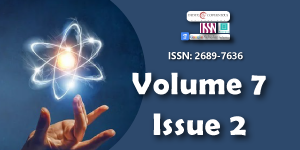Kinetic Modeling of Mass Loss during Carbonization of Sodium Carboxymethyl Cellulose (CMC) Aerogels
Main Article Content
Abstract
The carbonization of sodium carboxymethyl cellulose (CMC) aerogels involves complex thermal decomposition processes leading to the formation of carbonaceous residues. Understanding the kinetics of mass loss during carbonization is vital for optimizing the production of CMC carbon aerogels with desired properties. In this study, a mathematical model is presented that describes the kinetics of mass loss during the carbonization process of CMC aerogels. This model considers the temperature and concentration dependence of CMC decomposition reactions and is validated against experimental data obtained at various conditions. The proposed kinetic model elucidates the underlying mechanisms governing mass loss during carbonization, offering valuable insights for the design and optimization of CMC carbon aerogels across diverse applications. Furthermore, the analysis of the experimental data reveals variations in both the reaction order and the rate constant for different concentrations of CMC aerogels, indicating distinct kinetic behavior. These findings contribute to a deeper understanding of the carbonization process and pave the way for tailored synthesis approaches to meet specific application requirements.
Downloads
Article Details
Copyright (c) 2024 Shapiee N.

This work is licensed under a Creative Commons Attribution 4.0 International License.
Ghaffari-Mosanenzadeh S, Tafreshi OA, Karamikamkar S, Saadatnia Z, Rad E, Meysami M, et al. Recent advances in tailoring and improving the properties of polyimide aerogels and their application. Adv Colloid Interface Sci. 2022;304:102646. Available from: https://doi.org/10.1016/j.cis.2022.102646
Rashid AB, Shishir SI, Mahfuz MA, Hossain MT, Hoque ME. Silica aerogel: Synthesis, characterization, applications, and recent advancements. Part Part Syst Charact. 2023;40(6):2200186. Available from: https://doi.org/10.1002/ppsc.202200186
Barrios E, Fox D, Li Sip YY, Catarata R, Calderon JE, Azim N, et al. Nanomaterials in advanced, high-performance aerogel composites: A review. Polymers. 2019;11(4):726. Available from: https://doi.org/10.3390/polym11040726
Yang M, Zhao N, Cui Y, Gao W, Zhao Q, Gao C, et al. Biomimetic architectured graphene aerogel with exceptional strength and resilience. ACS Nano. 2017;11(7):6817-24. Available from: https://doi.org/10.1021/acsnano.7b01815
Peng H, Xiong W, Yang Z, Xu Z, Cao J, Jia M, et al. Advanced MOFs@ aerogel composites: construction and application towards environmental remediation. J Hazard Mater. 2022;432:128684. Available from: https://doi.org/10.1016/j.jhazmat.2022.128684
García-González CA, Budtova T, Durães L, Erkey C, Del Gaudio P, Gurikov P, et al. An opinion paper on aerogels for biomedical and environmental applications. Molecules. 2019;24(9):1815. Available from: https://doi.org/10.3390/molecules24091815
Pinto E, Aggrey WN, Boakye P, Amenuvor GA, Sokama-Neuyam YA, Fokuo MK, et al. Cellulose processing from biomass and its derivatization into carboxymethylcellulose: A review. Sci Afr. 2022;15: e01078. Available from: https://doi.org/10.1016/j.sciaf.2021.e01078
Li X, Wan C, Tao T, Chai H, Huang Q, Chai Y, et al. An overview of the development status and applications of cellulose-based functional materials. Cellulose. 2024;31(1):61-99. Available from: https://www.springerprofessional.de/en/an-overview-of-the-development-status-and-applications-of-cellul/26511226
Ani PC, Nzereogu PU, Agbogu AC, Ezema FI, Nwanya AC. Cellulose from waste materials for electrochemical energy storage applications: A review. Appl Surf Sci Adv. 2022;11:100298. Available from: http://dx.doi.org/10.1016/j.apsadv.2022.100298
Maleki H. Recent advances in aerogels for environmental remediation applications: A review. Chem Eng J. 2016;300:98-118. Available from: http://dx.doi.org/10.1016/j.cej.2016.04.098
Konuk OP, Alsuhile AA, Yousefzadeh H, Ulker Z, Bozbag SE, García-González CA, et al. The effect of synthesis conditions and process parameters on aerogel properties. Front Chem. 2023;11:767469. Available from: https://doi.org/10.3389/fchem.2023.1294520
Lin CC, Metters AT. Hydrogels in controlled release formulations: network design and mathematical modeling. Adv Drug Deliv Rev. 2006;58(12-13):1379-1408. Available from: https://doi.org/10.1016/j.addr.2006.09.004
Atik AAA, Hassan MHA, Azhari S, Nasir NA. Preparation and mass loss study of sodium carboxymethyl cellulose carbon aerogel prepared from non-hazardous material. Malays J Sci Health Technol. 2024;10(1):1-6. Available from: Available from: https://mjosht.usim.edu.my/index.php/mjosht/article/view/349.
Hu P, Tan B, Long M. Advanced nanoarchitectures of carbon aerogels for multifunctional environmental applications. Nanotechnol Rev. 2016;5(1):23-39. Available from: https://doi.org/10.1515/ntrev-2015-0050
Geng P, Zheng J, Li C, Zhang Y. Normalization of the power-law rate equation for determining the kinetic parameters of the char-CO2 reaction. Thermochim Acta. 2021;700:178933. Available from: https://doi.org/10.1016/j.tca.2021.178933
Zhang C, Valsaraj KT, Constant WD, Roy D. Aerobic biodegradation kinetics of four anionic and nonionic surfactants at sub-and supra-critical micelle concentrations (CMCs). Water Res. 1999;33(1):115-24. Available from: https://ui.adsabs.harvard.edu/link_gateway/1999WatRe..33..115Z/doi:10.1016/S0043-1354(98)00170-5
Vyazovkin S, Burnham AK, Favergeon L, Koga N, Moukhina E, Pérez-Maqueda LA, et al. ICTAC Kinetics Committee recommendations for analysis of multi-step kinetics. Thermochim Acta. 2020;689:178597. Available from: http://dx.doi.org/10.1016/j.tca.2020.178597
Matlab S. Matlab. The MathWorks, Natick, MA, 2014;9. Available from: https://www.mathworks.com/.
Xu Z, Zhang Y, Li P, Gao C. Strong, conductive, lightweight, neat graphene aerogel fibers with aligned pores. ACS Nano. 2012;6(8):7103-13. Available from: https://doi.org/10.1021/nn3021772
Wang YY, Zhou ZH, Zhu JL, Sun WJ, Yan DX, Dai K, et al. Low-temperature carbonized carbon nanotube/cellulose aerogel for efficient microwave absorption. Compos Part B Eng. 2021;220:108985. Available from: http://dx.doi.org/10.1016/j.compositesb.2021.108985
Ghafoorian NS, Bahramian AR, Seraji MM. Investigation of the effect of rice husk derived Si/SiC on the morphology and thermal stability of carbon composite aerogels. Mater Des. 2015;86:279-88. Available from: http://dx.doi.org/10.1016/j.matdes.2015.07.093
Wan C, Jiao Y, Wei S, Zhang L, Wu Y, Li J. Functional nanocomposites from sustainable regenerated cellulose aerogels: A review. Chem Eng J. 2019;359:459-75. Available from: https://ui.adsabs.harvard.edu/link_gateway/2019ChEnJ.359..459W/doi:10.1016/j.cej.2018.11.115
Román S, Libra J, Berge N, Sabio E, Ro K, Li L, et al. Hydrothermal carbonization: Modeling, final properties design and applications: A review. Energies. 2018;11(1):216. Available from: https://www.mdpi.com/1996-1073/11/1/216
Gulzar U, Goriparti S, Miele E, Li T, Maidecchi G, Toma A, et al. Next-generation textiles: from embedded supercapacitors to lithium ion batteries. J Mater Chem A. 2016;4(43):16771-800. Available from: https://pubs.rsc.org/en/content/articlelanding/2016/ta/c6ta06437j
Maleki H, Hüsing N. Aerogels as promising materials for environmental remediation—a broad insight into the environmental pollutants removal through adsorption and (photo)catalytic processes. In: New polymer nanocomposites for environmental remediation. Elsevier; 2018;389-436. Available from: https://doi.org/10.1016/B978-0-12-811033-1.00016-0

